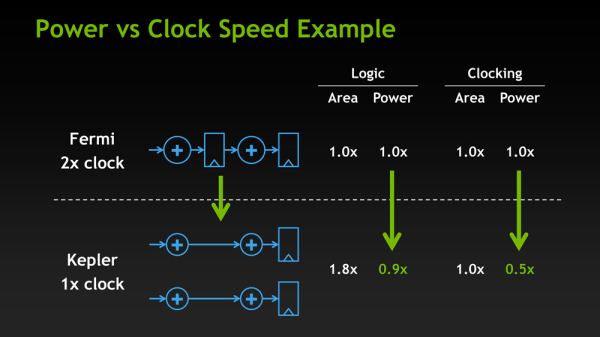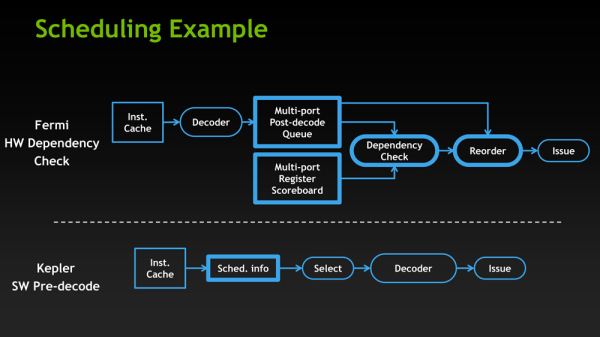NVIDIA GeForce GTX 680 Review: Retaking The Performance Crown
by Ryan Smith on March 22, 2012 9:00 AM ESTThe Kepler Architecture: Efficiency & Scheduling
So far we’ve covered how NVIDIA has improved upon Fermi for; now let’s talk about why.
Mentioned quickly in our introduction, NVIDIA’s big push with Kepler is efficiency. Of course Kepler needs to be faster (it always needs to be faster), but at the same time the market is making a gradual shift towards higher efficiency products. On the desktop side of matters GPUs have more or less reached their limits as far as total power consumption goes, while in the mobile space products such as Ultrabooks demand GPUs that can match the low power consumption and heat dissipation levels these devices were built around. And while strictly speaking NVIDIA’s GPUs haven’t been inefficient, AMD has held an edge on performance per mm2 for quite some time, so there’s clear room for improvement.
In keeping with that ideal, for Kepler NVIDIA has chosen to focus on ways they can improve Fermi’s efficiency. As NVIDIA's VP of GPU Engineering, Jonah Alben puts it, “[we’ve] already built it, now let's build it better.”
There are numerous small changes in Kepler that reflect that goal, but of course the biggest change there was the removal of the shader clock in favor of wider functional units in order to execute a whole warp over a single clock cycle. The rationale for which is actually rather straightforward: a shader clock made sense when clockspeeds were low and die space was at a premium, but now with increasingly small fabrication processes this has flipped. As we have become familiar with in the CPU space over the last decade, higher clockspeeds become increasingly expensive until you reach a point where they’re too expensive – a point where just distributing that clock takes a fair bit of power on its own, not to mention the difficulty and expense of building functional units that will operate at those speeds.
With Kepler the cost of having a shader clock has finally become too much, leading NVIDIA to make the shift to a single clock. By NVIDIA’s own numbers, Kepler’s design shift saves power even if NVIDIA has to operate functional units that are twice as large. 2 Kepler CUDA cores consume 90% of the power of a single Fermi CUDA core, while the reduction in power consumption for the clock itself is far more dramatic, with clock power consumption having been reduced by 50%.
Of course as NVIDIA’s own slide clearly points out, this is a true tradeoff. NVIDIA gains on power efficiency, but they lose on area efficiency as 2 Kepler CUDA cores take up more space than a single Fermi CUDA core even though the individual Kepler CUDA cores are smaller. So how did NVIDIA pay for their new die size penalty?
Obviously 28nm plays a significant part of that, but even then the reduction in feature size from moving to TSMC’s 28nm process is less than 50%; this isn’t enough to pack 1536 CUDA cores into less space than what previously held 384. As it turns out not only did NVIDIA need to work on power efficiency to make Kepler work, but they needed to work on area efficiency. There are a few small design choices that save space, such as using 8 SMXes instead of 16 smaller SMXes, but along with dropping the shader clock NVIDIA made one other change to improve both power and area efficiency: scheduling.
GF114, owing to its heritage as a compute GPU, had a rather complex scheduler. Fermi GPUs not only did basic scheduling in hardware such as register scoreboarding (keeping track of warps waiting on memory accesses and other long latency operations) and choosing the next warp from the pool to execute, but Fermi was also responsible for scheduling instructions within the warps themselves. While hardware scheduling of this nature is not difficult, it is relatively expensive on both a power and area efficiency basis as it requires implementing a complex hardware block to do dependency checking and prevent other types of data hazards. And since GK104 was to have 32 of these complex hardware schedulers, the scheduling system was reevaluated based on area and power efficiency, and eventually stripped down.
The end result is an interesting one, if only because by conventional standards it’s going in reverse. With GK104 NVIDIA is going back to static scheduling. Traditionally, processors have started with static scheduling and then moved to hardware scheduling as both software and hardware complexity has increased. Hardware instruction scheduling allows the processor to schedule instructions in the most efficient manner in real time as conditions permit, as opposed to strictly following the order of the code itself regardless of the code’s efficiency. This in turn improves the performance of the processor.
However based on their own internal research and simulations, in their search for efficiency NVIDIA found that hardware scheduling was consuming a fair bit of power and area for few benefits. In particular, since Kepler’s math pipeline has a fixed latency, hardware scheduling of the instruction inside of a warp was redundant since the compiler already knew the latency of each math instruction it issued. So NVIDIA has replaced Fermi’s complex scheduler with a far simpler scheduler that still uses scoreboarding and other methods for inter-warp scheduling, but moves the scheduling of instructions in a warp into NVIDIA’s compiler. In essence it’s a return to static scheduling.
Ultimately it remains to be seen just what the impact of this move will be. Hardware scheduling makes all the sense in the world for complex compute applications, which is a big reason why Fermi had hardware scheduling in the first place, and for that matter why AMD moved to hardware scheduling with GCN. At the same time however when it comes to graphics workloads even complex shader programs are simple relative to complex compute applications, so it’s not at all clear that this will have a significant impact on graphics performance, and indeed if it did have a significant impact on graphics performance we can’t imagine NVIDIA would go this way.
What is clear at this time though is that NVIDIA is pitching GTX 680 specifically for consumer graphics while downplaying compute, which says a lot right there. Given their call for efficiency and how some of Fermi’s compute capabilities were already stripped for GF114, this does read like an attempt to further strip compute capabilities from their consumer GPUs in order to boost efficiency. Amusingly, whereas AMD seems to have moved closer to Fermi with GCN by adding compute performance, NVIDIA seems to have moved closer to Cayman with Kepler by taking it away.
With that said, in discussing Kepler with NVIDIA’s Jonah Alben, one thing that was made clear is that NVIDIA does consider this the better way to go. They’re pleased with the performance and efficiency they’re getting out of software scheduling, going so far to say that had they known what they know now about software versus hardware scheduling, they would have done Fermi differently. But whether this only applies to consumer GPUs or if it will apply to Big Kepler too remains to be seen.












404 Comments
View All Comments
SlyNine - Friday, March 23, 2012 - link
lol, you're way of the mark.My point wasn't that the 680GTX isn't faster, it's however that it does stand up well against the 680GTX in performance.
As far as compute goes, I'm not sure I understand your premise. Frankly I think it's an invalid inference. I said kills it. If that somehow implies it means it losses in the other compute tests, I'm not sure how you got there. Again invalid inference of the data.
Galidou - Friday, March 23, 2012 - link
You didn't get the point of what he meant. Yes AMD is loosing but mostly in games that already run 60+fps. The games AMD wins is where it's still not maxed out yet(below 60 fps).Which maybe means if some big demanding games come out, the winning/loosing shceme might go back and forth. But right now, not much games out there will push those gpus unless you got very high resolutions and right now, I think 90% of gamers have 1080p and lower which still runs super smooth with 95% of graphical options enables on a 150$ GPU...
Still gotta say that this GTX 680 is really good for a flagship and the first one that's not uber huge and noisy and hot...
CeriseCogburn - Tuesday, March 27, 2012 - link
Shogun 2 TOTAL WAR, in this bench set is THE HARDEST GAME, not metro2033 and not crysis warhead.Sorry feller but ignoring that gets you guys the big fib you want.
Sorry.
CeriseCogburn - Tuesday, March 27, 2012 - link
SHOGUN 2 680 wins in top rez.from article " Total War: Shogun 2 is the latest installment of the long-running Total War series of turn based strategy games, and alongside Civilization V is notable for just how many units it can put on a screen at once. As it also turns out, it’s the single most punishing game in our benchmark suite"
OH WELL guess it's the metro2033 and crysis game engines cause the hardest game Nvidia 680 wins.
CeriseCogburn - Tuesday, March 27, 2012 - link
No you're WRONG. 1. 608 wins 1 bench in Merto2033, and ties within bench error on the other two resolutions.The hardest game as stated by the reviewer (since you never read) is Shogun2 total war, and Nvidia makes a clean sweep at all resolutions there.
In fact the Nvidia card wins everything but Crysis here, ties on Metro, and smokes everything else.
If Metro isn't a tie, take a look at the tie Ryan has for Civ5 and get back to me... !
(hint: Nvidia wins by far more in Civ5)
So--- let's see, one game with wierd benching old benching and AMD favored benchmark (dumping the waterfall bench that Nvidia won on all the time) >(Crysis)
One "tie" metro2033, then Nvidsia sweeps the rest of them. many by gigantic frame rate victories.
Other places show Nvidia winning metro2003 by a lot. (pureoverclock for one)
....
No I'm not the one fudging, spinning and worse. You guys are. You lost, lost bad, man up.
b3nzint - Monday, March 26, 2012 - link
gt680 got more clocks, way higher memory bandwidth than 7970 thats why it got lower power load and price. but i think we can only compare 2 things if they have the "same" engine like drag race cars. both of them made a big leap from previous tech. and thats a win for us.btw, who comes out first ..amd. i say amd win period. so next time maybe they must release next gen gpu on the same time.
b3nzint - Monday, March 26, 2012 - link
sorry what i meant was gtx 680 has lower memory, so it gain lower power.CeriseCogburn - Tuesday, March 27, 2012 - link
Or so a memory overclock unleashes it and it screams even further away at the tops of the charts...dlitem - Thursday, March 22, 2012 - link
Actual street prices can be different:At least here on the eastern shores of Atlantic ocean German retailers are selling 7970's starting 460-470 eur including taxes with cards on stock and GTX680's are starting 499eur with taxes...
TheRealArdrid - Thursday, March 22, 2012 - link
Sigh, are people really relying on that weak argument again? It's the same thing people said when Intel starting trouncing AMD: it's not fair because Intel has Turbo Boost.